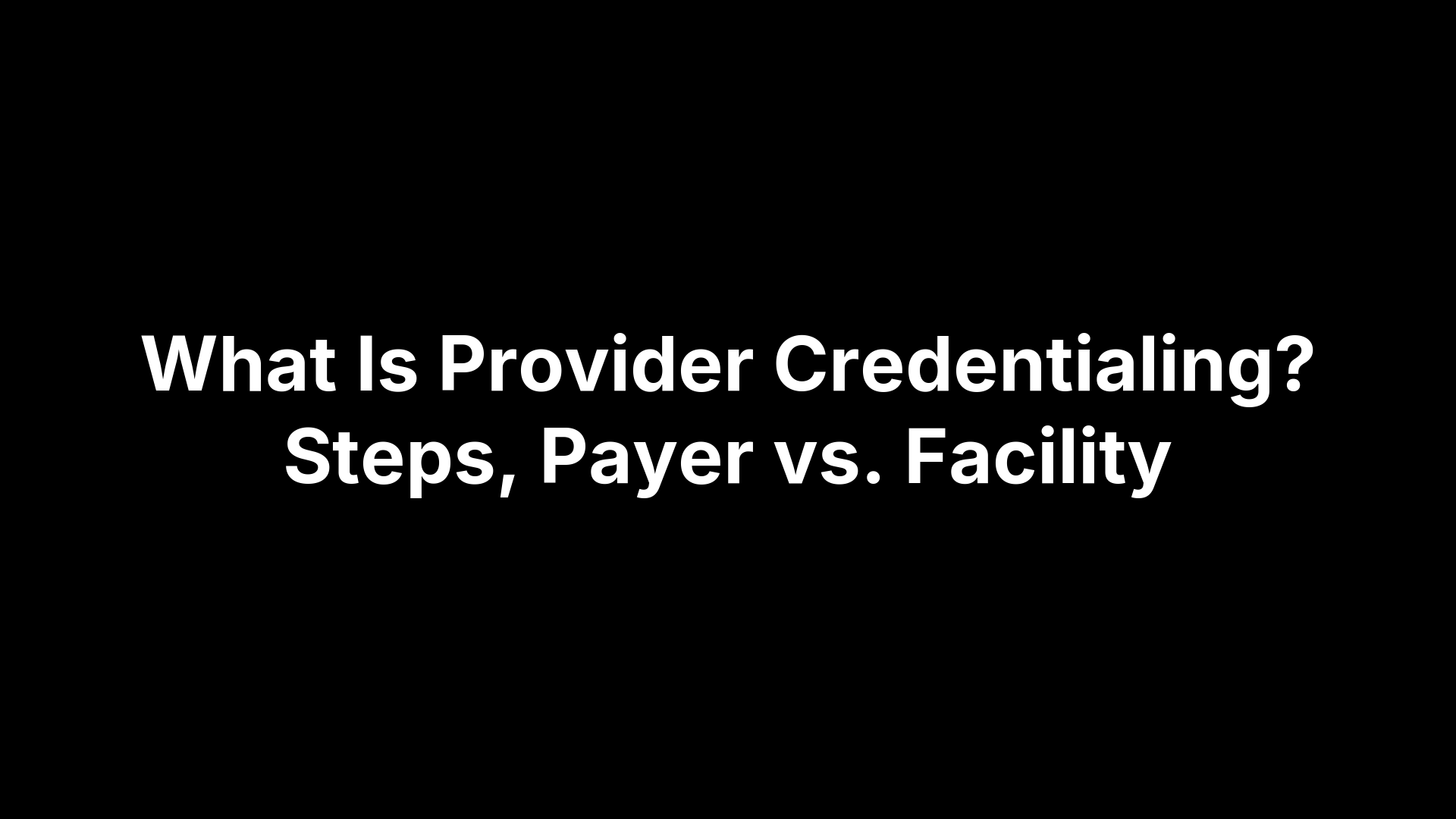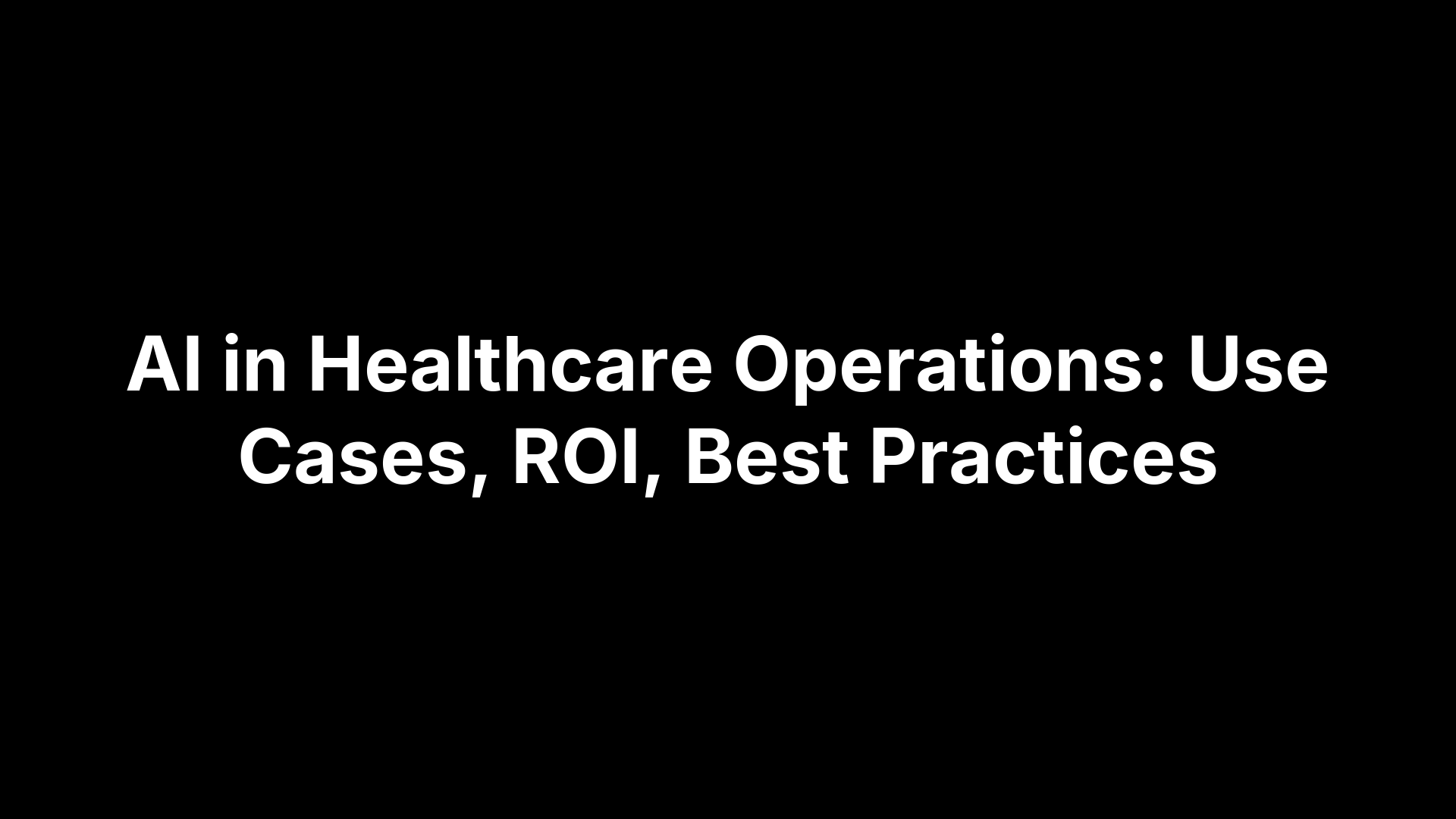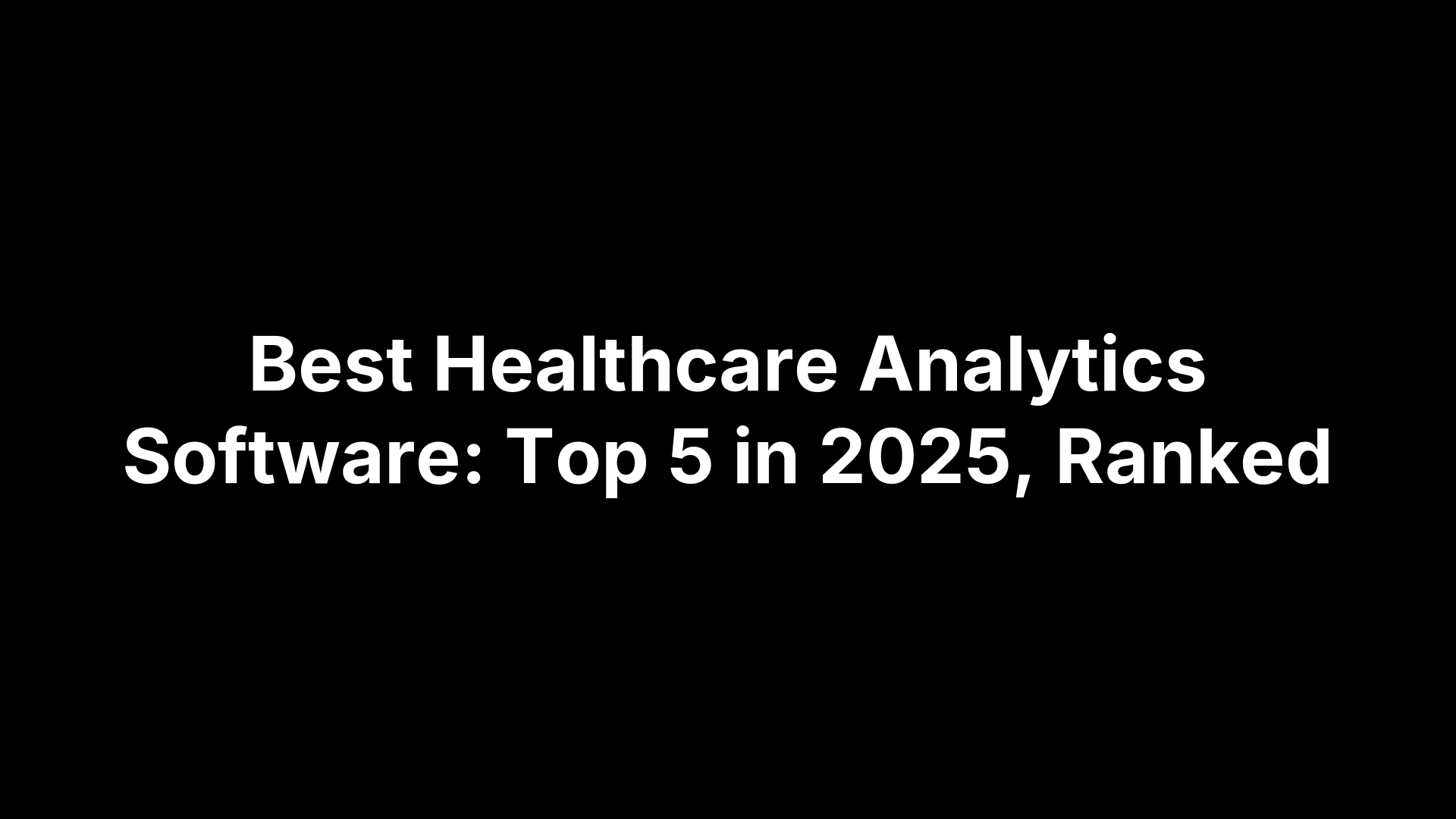What Is Provider Credentialing? Steps, Payer vs. Facility


What Is Provider Credentialing? Steps, Payer vs. Facility
Provider credentialing is the formal vetting that health plans and healthcare organizations use to confirm a clinician’s education, training, licensure, and professional history before allowing them to treat patients, bill payers, or appear in a network. Think of it as the safety and quality checkpoint that also unlocks reimbursement. It happens at hire and again on a regular cycle (often every two years), with ongoing monitoring in between. Done well, credentialing keeps patients safe and organizations compliant; done poorly, it stalls start dates, delays revenue, and creates operational headaches.
This guide explains why credentialing exists, who needs it, and how it differs from privileging, payer enrollment, and contracting. You’ll see the key differences between facility and payer credentialing, the exact steps from application to approval, the documents you’ll need, realistic timelines (and what speeds them up), recredentialing expectations, common pitfalls to avoid, and the standards that govern it (CMS, Joint Commission, NCQA, and state rules). We’ll also highlight technology and automation trends—and how VectorCare streamlines vendor onboarding and credentialing workflows—so you can move providers into service faster with fewer surprises.
Why provider credentialing exists (safety, quality, reimbursement)
Provider credentialing exists to protect patients and organizations. By verifying education, training, licenses, and any sanctions directly with the issuing sources, hospitals and health plans confirm clinicians are competent and safe to practice. It supports quality and accreditation goals (e.g., Joint Commission) and fulfills CMS and payer requirements so providers can be granted privileges, join networks, and receive Medicare/Medicaid or commercial reimbursement. Ongoing recredentialing and monitoring reduce liability, deter fraud, and keep rosters accurate.
Who needs credentialing (provider types and settings)
Any clinician who will treat patients within an organization or bill an insurer typically needs provider credentialing. Hospitals and health systems credential employed and affiliated medical staff, while managed care organizations and government payers (e.g., Medicare/Medicaid) credential providers to verify qualifications before network participation and reimbursement.
- Provider types: Physicians (MD/DO), dentists, nurse practitioners, physician assistants, behavioral health clinicians, therapists, and other allied health professionals.
- Settings: Hospital medical staff rosters and health system networks; commercial health plans and government payers for in-network participation; credentialing verification organizations (CVOs) may perform checks on behalf of facilities or payers.
Credentialing vs privileging vs payer enrollment vs contracting
These four terms are often blurred, but each marks a different checkpoint on the road to letting a clinician practice and get paid. Knowing what is provider credentialing versus privileging, payer enrollment, and contracting helps you set timelines, assign owners, and avoid costly do-overs across both the facility and health plan sides.
- Credentialing: Verification of a provider’s education, training, licensure, certifications, and history via primary source checks by a hospital, health plan, or CVO to confirm competence and eligibility.
- Privileging: A facility’s decision to grant specific clinical privileges (scope/procedures) based on verified training and experience; typically approved by medical staff leadership.
- Payer enrollment: Applying to insurers (commercial and government) to join their network so services can be billed and reimbursed; often runs alongside but is distinct from credentialing.
- Contracting: Negotiating and executing the participation agreement with a payer that sets obligations, reimbursement terms, and effective dates; without an executed contract, payment terms aren’t in force.
Facility credentialing vs payer credentialing
Facility and payer credentialing answer the same safety question—does this clinician meet standards?—but they serve different gatekeepers and unlock different outcomes. Hospitals and health systems credential to support medical staff decisions and, together with privileging, allow a provider to practice inside the facility. Health plans and government programs credential to admit providers into networks so claims can be billed and reimbursed. Many organizations run both tracks in parallel, but they follow separate policies and approvals.
- Facility credentialing: Run by hospitals/health systems (or a CVO) to verify qualifications and support privileging by medical staff leadership.
- Payer credentialing: Run by insurers and government payers to determine network participation and reimbursement eligibility.
- Verification method: Both rely on primary source verification of education, licensure, board status, and history.
- Standards focus: Facilities align with Joint Commission; payers align with CMS and NCQA expectations.
- Timelines: Either can take ~30 days to six months or more, especially if processes are paper-based.
The provider credentialing steps (start to finish)
From application to approval, provider credentialing follows a repeatable workflow that facilities, payers, or a credentialing verification organization (CVO) can run. The goal is to verify qualifications via primary source verification and resolve gaps so leaders can grant privileges or payers can set network effective dates without delays.
- Apply and submit data: Demographics, CV, education/training, licenses, affiliations, malpractice coverage, references, and disclosures via an application or centralized profile.
- Primary source verification (PSV): Confirm education, training, state licensure, board status, DEA (as applicable), and other credentials directly with issuing sources.
- Sanctions and history checks: Review malpractice claims, licensure actions, and exclusion lists; reconcile discrepancies.
- File assembly and quality review: Credentialing staff compile findings, document gaps, and obtain clarifications.
- Committee/administrative decision: Appropriate leaders review and approve/deny; facilities use the file to support privileging, payers use it to determine network eligibility.
- Finalize and publish: Issue approvals, set effective dates, update rosters/directories, and notify stakeholders.
- Ongoing monitoring: Track license/board expirables and schedule recredentialing (commonly every two years).
What gets verified: documents and data you’ll need
Provider credentialing relies on primary source verification to confirm a clinician’s qualifications and history. Whether a facility or a payer is credentialing, the core checklist is similar. Having complete, current documents minimizes back-and-forth and keeps timelines on track. Here’s what is typically requested and verified during provider credentialing, with sources contacted directly to validate accuracy.
- Government ID: May require notarized identification.
- Current CV: Continuous work and training history.
- Education/training: Medical school, residency, fellowships.
- Licensure: Active state licenses; certificates.
- DEA registration: If applicable to role and scope.
- Board certification: Current status and exam dates.
- Affiliations: Hospital and medical group memberships.
- Malpractice: Coverage proof and claim history.
- Sanctions/discipline: Licensure actions or reportable events.
- References: Peer or professional recommendations.
- Background checks: As required by policy or regulation.
How long credentialing takes (and what speeds it up)
Timelines vary: provider credentialing can finish in about 30 days or take six months or more, depending on application completeness, primary source verification (PSV) turnaround, and review cycles. Paper or fax-based workflows slow things down. Running facility and payer tracks in parallel and using digital processes significantly reduces back‑and‑forth and accelerates approvals.
- Gap-free application: Continuous CV, training, and work history.
- Current credentials: Active licenses, DEA (if applicable), board status, malpractice coverage.
- PSV-ready contacts: Accurate schools, boards, references, and affiliations.
- Quick follow-up: Rapid responses to clarification or discrepancy requests.
- Digital, integrated workflow: Submit online and align payer enrollment with credentialing.
Recredentialing and ongoing monitoring requirements
Credentialing isn’t “one and done.” Facilities and payers recredential providers on a set cadence—commonly every two years—to reconfirm qualifications and continued competence before renewing privileges or network status. Between cycles, organizations perform ongoing monitoring to catch changes early and prevent lapses that jeopardize patient safety, accreditation, or reimbursement.
- Recredentialing scope: Verify licenses, board status, DEA (if applicable), malpractice coverage, affiliations, and any new claims or disciplinary actions.
- Expirables tracking: Monitor license, certification, DEA, and insurance renewal dates to avoid privilege or network interruptions.
- Sanctions monitoring: Watch for actions or exclusions and investigate discrepancies promptly.
- Roster accuracy: Keep provider demographics and affiliations current for internal systems and payer directories.
- Trigger-based reviews: Initiate reviews upon adverse events, scope changes, or relocation to new states.
Common pitfalls and how to avoid delays
In provider credentialing, small misses create big delays—start dates slip, privileges stall, and payers hold claims. Most bottlenecks are preventable with front-loaded completeness and fast follow-up. Use this preflight checklist to remove the usual suspects before your file hits a committee or payer queue.
- Incomplete application: Submit a complete, consistent packet up front.
- Unexplained CV gaps: Ensure continuous months; explain any breaks.
- Expired/mismatched credentials: Active licenses/DEA/insurance; names must match.
- Slow PSV: Accurate contacts, signed releases, digital docs, rapid follow‑up.
- Weak references: Current peers, direct numbers, confirm availability to respond.
- Nondisclosure of sanctions/claims: Disclose early with context and remediation.
Compliance standards to know (CMS, Joint Commission, NCQA, state)
Credentialing isn’t just best practice—it’s required. CMS and the Joint Commission mandate verified qualifications before care or reimbursement, payers align to NCQA program standards, and states layer on their own rules. Across these frameworks, you’ll see primary source verification, documented reviews, recredentialing roughly every two years, and continuous monitoring of licenses, sanctions, and coverage.
- CMS: Requires credentialing before Medicare/Medicaid reimbursement; confirms providers meet federal standards.
- Joint Commission: Accreditation expects rigorous credentialing and privileging supported by primary source verification.
- NCQA (payers): Guides health plan credentialing and recredentialing programs, including PSV and defined review cycles.
- State regulations: Insurance departments and medical boards set additional requirements; confirm state-specific policies and timelines.
Technology and automation trends in credentialing
Modern credentialing is moving from paper-based, siloed workflows to connected, digital programs. Organizations are integrating credentialing with payer enrollment to eliminate duplicate steps, adopting cloud platforms for remote collaboration, and reusing verified data across quality, safety, and risk to reduce rework. Continuous monitoring automates expirables and sanctions checks, speeding approvals and strengthening compliance.
- Paperless PSV: Secure portals replace fax/mail for primary source verification and document exchange.
- Cloud collaboration: CVO and committee reviews run remotely with audit-ready files.
- Integrated data: APIs sync provider data with EHRs and directory management to keep rosters current.
- Automated monitoring: Real-time alerts for license, DEA, board, and malpractice expirables and sanctions.
How VectorCare helps with vendor onboarding and credentialing workflows
When onboarding stalls, transports miss windows and discharges back up. VectorCare unifies vendor onboarding and provider credentialing across NEMT, DME, and home care networks so compliance isn’t an afterthought—it’s built into how work gets assigned. Trust, Hub, Connect, and Insights work together to collect requirements once, enforce policies everywhere, and keep your network activation-ready.
- Trust (vendor network): Centralize vendor profiles, required documents, contracts, and configurable policies that gate activation and service assignment.
- Hub (workflows): Automate onboarding checklists, approvals, and secure messaging with an audit-ready trail.
- Connect (integrations): Sync credentialing status with EHR, CAD, and billing systems to prevent downstream mismatches.
- Insights (BI): Monitor onboarding throughput, see bottlenecks, and forecast coverage gaps.
- Dispatch tie-in: Use policy enforcement so only compliant, contracted vendors receive requests—no manual triage required.
Key takeaways
Credentialing verifies qualifications to protect patients and unlock payment. Facilities use it (with privileging) to let clinicians practice; payers use it to admit providers into networks. Expect primary source verification, recredentialing about every two years, ongoing monitoring, and timelines of roughly 30 days to six months, depending on completeness and process. For faster, compliant onboarding across vendors, explore VectorCare.
- Separate tracks: Facility vs payer; parallel, distinct approvals.
- Documentation matters: Gap-free CV, active licenses, accurate disclosures.
- Digitize to accelerate: Paperless PSV and integrated workflows cut delays.
The Future of Patient Logistics
Exploring the future of all things related to patient logistics, technology and how AI is going to re-shape the way we deliver care.



